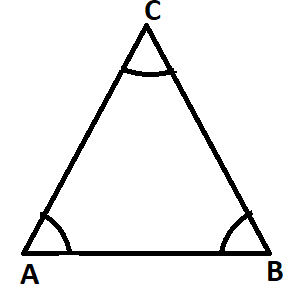
If in triangle $ABC$, $\cos A=\frac{\sin B}{2\sin C}$ then the triangle is
A. Equilateral.
B. Isosceles.
C. Right angled.
D. None of these.
Answer
216.3k+ views
Hint: To solve this question, we will write the given equation $\cos A=\frac{\sin B}{2\sin C}$ in terms of $\sin B$ and consider it as first equation. We will use angle sum property of triangle and write the equation in terms of the angle $B$. Then we will substitute the value of angle $B$derived in the first equation and simplify it using trigonometric formulas. After this we will get the resultant equation which will be property of some triangle which in terms will help in determining the type of triangle.
Formula used:
\[\begin{align}
& \sin (A+B)=\sin A\cos B+\cos A\sin B \\
& \sin (A-B)=\sin A\cos B-\cos A\sin B \\
\end{align}\]
Complete step-by-step solution:
We are given a triangle $ABC$such that $\cos A=\frac{\sin B}{2\sin C}$and we have to determine the type of the triangle $ABC$ is.
We will use the given equation $\cos A=\frac{\sin B}{2\sin C}$ and write it in terms of $\sin B$,
$2\sin C\cos A=\sin B\,\,\,\,......(i)$
Now we will use angle sum property of the triangle,
$\begin{align}
& A+B+C=\pi \\
& B=\pi -(A+C).....(ii)
\end{align}$
We will now substitute the equation (ii) in equation (i),
$\begin{align}
& 2\sin C\cos A=\sin (\pi -(A+C)) \\
& 2\sin C\cos A=\sin (A+C)
\end{align}$
We will now use the formula of \[\sin (A+B)\],
\[\begin{align}
& 2\cos A\sin C=\sin A\cos C+\cos A\sin C \\
& 2\cos A\sin C-\cos A\sin C-\sin A\cos C=0 \\
& \cos A\sin C-\sin A\cos C=0
\end{align}\]
We know that \[\cos A\sin C-\sin A\cos C\] is the formula of $\sin (C-A)$, so
\[\begin{align}
& \sin (C-A)=0 \\
& \sin (C-A)=\sin 0 \\
& C-A=0 \\
& C=A
\end{align}\]
Two angles of the triangle are equal. We will now draw the triangle,

We know the isosceles property of the triangle according to which sides opposite to equal angles are equal which means that if angles $C=A$ then their opposite will be also equal that is $AC=AB$.
And if two sides are equal then that angle is an isosceles triangle.
The triangle $ABC$ such that$\cos A=\frac{\sin B}{2\sin C}$ is an isosceles triangle. Hence the correct option is (B).
Note:
We could have also solved this question using cosine rule and Law of sine.
Using Law of sine $\frac{a}{\sin A}=\frac{b}{\sin B}=\frac{c}{\sin C}$, we will derive the value of $\frac{\sin B}{\sin C}$.
\[\begin{align}
& \frac{b}{\sin B}=\frac{c}{\sin C} \\
& \frac{b}{c}=\frac{\sin B}{\sin C} \\
\end{align}\]
We will now use cosine rule $\cos A=\frac{{{b}^{2}}+{{c}^{2}}-{{a}^{2}}}{2bc}$ and equation we derived \[\frac{b}{c}=\frac{\sin B}{\sin C}\] in $\cos A=\frac{\sin B}{2\sin C}$.
$\frac{{{b}^{2}}+{{c}^{2}}-{{a}^{2}}}{2bc}=\frac{b}{2c}$
Solving this equation we will get equation $c=a$. As both sides are equal then the triangle will be isosceles.
Formula used:
\[\begin{align}
& \sin (A+B)=\sin A\cos B+\cos A\sin B \\
& \sin (A-B)=\sin A\cos B-\cos A\sin B \\
\end{align}\]
Complete step-by-step solution:
We are given a triangle $ABC$such that $\cos A=\frac{\sin B}{2\sin C}$and we have to determine the type of the triangle $ABC$ is.
We will use the given equation $\cos A=\frac{\sin B}{2\sin C}$ and write it in terms of $\sin B$,
$2\sin C\cos A=\sin B\,\,\,\,......(i)$
Now we will use angle sum property of the triangle,
$\begin{align}
& A+B+C=\pi \\
& B=\pi -(A+C).....(ii)
\end{align}$
We will now substitute the equation (ii) in equation (i),
$\begin{align}
& 2\sin C\cos A=\sin (\pi -(A+C)) \\
& 2\sin C\cos A=\sin (A+C)
\end{align}$
We will now use the formula of \[\sin (A+B)\],
\[\begin{align}
& 2\cos A\sin C=\sin A\cos C+\cos A\sin C \\
& 2\cos A\sin C-\cos A\sin C-\sin A\cos C=0 \\
& \cos A\sin C-\sin A\cos C=0
\end{align}\]
We know that \[\cos A\sin C-\sin A\cos C\] is the formula of $\sin (C-A)$, so
\[\begin{align}
& \sin (C-A)=0 \\
& \sin (C-A)=\sin 0 \\
& C-A=0 \\
& C=A
\end{align}\]
Two angles of the triangle are equal. We will now draw the triangle,

We know the isosceles property of the triangle according to which sides opposite to equal angles are equal which means that if angles $C=A$ then their opposite will be also equal that is $AC=AB$.
And if two sides are equal then that angle is an isosceles triangle.
The triangle $ABC$ such that$\cos A=\frac{\sin B}{2\sin C}$ is an isosceles triangle. Hence the correct option is (B).
Note:
We could have also solved this question using cosine rule and Law of sine.
Using Law of sine $\frac{a}{\sin A}=\frac{b}{\sin B}=\frac{c}{\sin C}$, we will derive the value of $\frac{\sin B}{\sin C}$.
\[\begin{align}
& \frac{b}{\sin B}=\frac{c}{\sin C} \\
& \frac{b}{c}=\frac{\sin B}{\sin C} \\
\end{align}\]
We will now use cosine rule $\cos A=\frac{{{b}^{2}}+{{c}^{2}}-{{a}^{2}}}{2bc}$ and equation we derived \[\frac{b}{c}=\frac{\sin B}{\sin C}\] in $\cos A=\frac{\sin B}{2\sin C}$.
$\frac{{{b}^{2}}+{{c}^{2}}-{{a}^{2}}}{2bc}=\frac{b}{2c}$
Solving this equation we will get equation $c=a$. As both sides are equal then the triangle will be isosceles.
Recently Updated Pages
JEE Atomic Structure and Chemical Bonding important Concepts and Tips

JEE Amino Acids and Peptides Important Concepts and Tips for Exam Preparation

Electricity and Magnetism Explained: Key Concepts & Applications

Chemical Properties of Hydrogen - Important Concepts for JEE Exam Preparation

JEE Energetics Important Concepts and Tips for Exam Preparation

JEE Isolation, Preparation and Properties of Non-metals Important Concepts and Tips for Exam Preparation

Trending doubts
JEE Main 2026: Application Form Open, Exam Dates, Syllabus, Eligibility & Question Papers

Derivation of Equation of Trajectory Explained for Students

Hybridisation in Chemistry – Concept, Types & Applications

Understanding the Angle of Deviation in a Prism

Understanding Collisions: Types and Examples for Students

How to Convert a Galvanometer into an Ammeter or Voltmeter

Other Pages
JEE Advanced Marks vs Ranks 2025: Understanding Category-wise Qualifying Marks and Previous Year Cut-offs

NCERT Solutions for Class 11 Maths Chapter 10 Conic Sections

NCERT Solutions for Class 11 Maths Chapter 9 Straight Lines

NCERT Solutions For Class 11 Maths Chapter 8 Sequences And Series

Understanding Atomic Structure for Beginners

NCERT Solutions For Class 11 Maths Chapter 12 Limits And Derivatives




